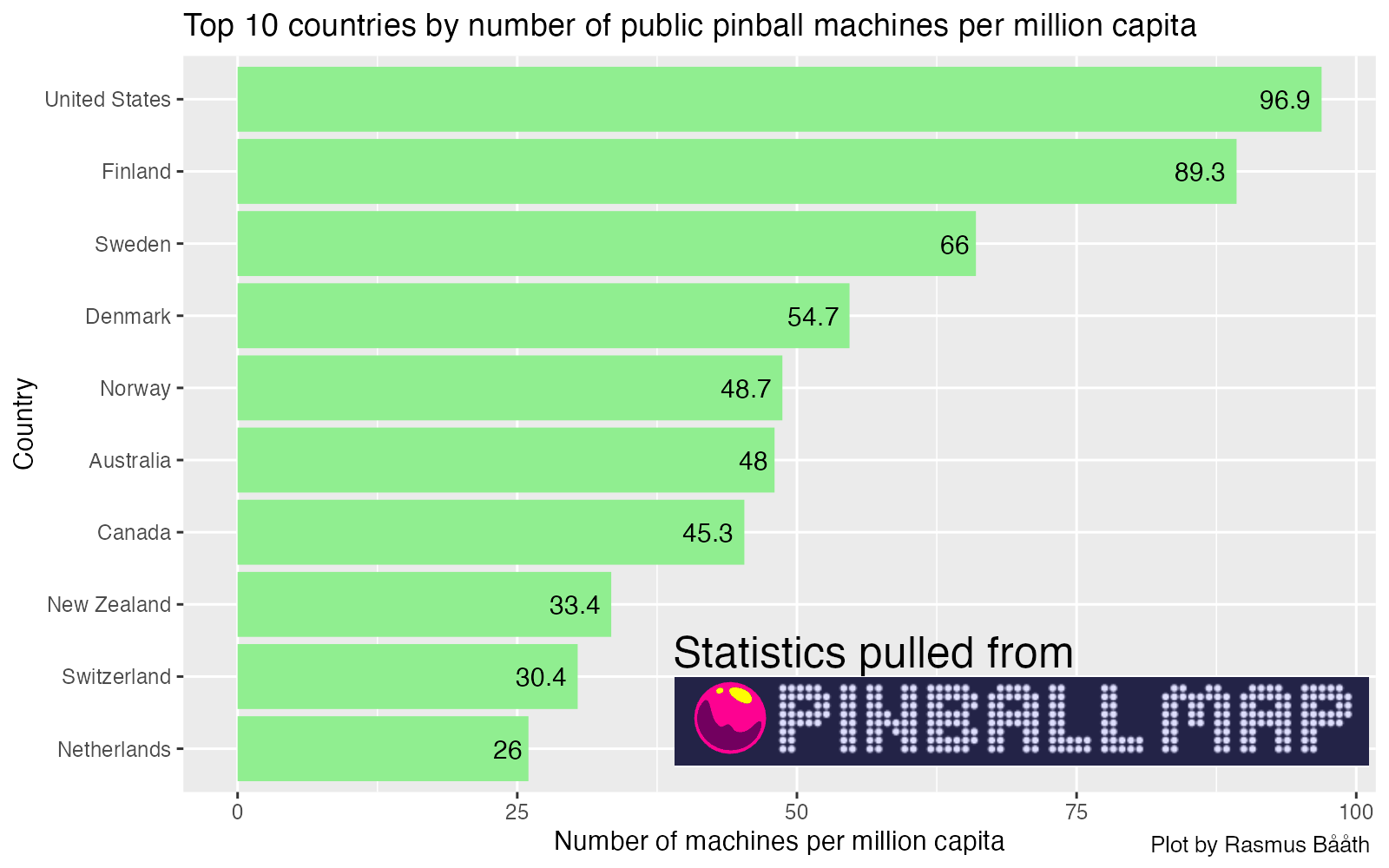There are tons of well-known global indicators. We’ve all heard of gross domestic product, life expectancy, rate of literacy, etc. But, ever since I discovered pinballmap.com, possibly the world’s most comprehensive database of public pinball locations, I’ve been thinking about a potential new global indicator: Public Pinball Machines per Capita. Thanks to Pinball Map’s well-documented public API, this indicator is now a reality!
 Here’s how this was put together (and just scroll to the bottom for a CSV file with this indicator for all countries).
Here’s how this was put together (and just scroll to the bottom for a CSV file with this indicator for all countries).
Pulling public pinball locations from Pinball Map
Pinball Map is, from what I can discern, the most popular app for finding out where there are arcades and bars with pinball machines. It’s open for anyone to register new pinball locations, but not only that, the app itself is open source, and the data it collects is available through a public API under a permissive licence! Using this API, we will pull essential data for our Public Pinball Machines per Capita indicator: all registered pinball locations and their respective machine counts.
Loading packages
Code for pulling pinball stats from the Pinball Map API
name country city lat lon num_machines
1 Arena Lanes Bowling Center US Oak Lawn 41.7 -87.7 3
2 Pete's Treats US Union Springs 42.9 -76.7 1
3 The Summit Windsor US Loveland 40.4 -105.0 6
4 Skylark Lounge US Denver 39.7 -105.0 2
5 The Escape Gamebar US Atlanta 33.9 -84.3 5
The above shows a sample of five out of the 10,330 locations where you can play pinball, as of June 2024. As we have the longitude and latitude we can also figure out that the northernmost place to play pinball is in Rovaniemi, Finland, and the southernmost place is in Woolston, New Zealand.
Code
name country city lat lon num_machines
1 Kauppayhtiö FI Rovaniemi 66.5 25.7 2
10330 Fish & Chips On Ferry NZ Woolston -43.5 172.7 1
Or, why not just plot all pinball locations on a world map?
Plot code

Finally, we can now sum up how many public pinball machines there are in each country, where the USA, unsurprisingly, takes the lead.
Code
# A tibble: 65 × 3
country n_locations n_machines
<chr> <int> <int>
1 US 7831 32287
2 CA 511 1765
3 AU 427 1247
4 DE 129 1099
5 FR 247 707
6 SE 79 692
7 GB 160 500
8 FI 98 496
9 NL 69 461
10 JP 86 351
# ℹ 55 more rows
Calculating Public Pinball Machines per Capita
Knowing how many public pinball machines there are in each country isn’t enough, we also need to consider the size of the population. Thanks to the WDI package it’s easy to pull this, and any other indicators you fancy, from the World Bank Open Data and to calculate the number of Public Pinball Machines per Capita (here per million people).
Code for pulling World Development Indicators
Code for calculating Public Pinball Machines per Capita
# A tibble: 58 × 4
country_name population n_machines n_machines_per_million_capita
<chr> <dbl> <int> <dbl>
1 United States 333287557 32287 96.9
2 Finland 5556106 496 89.3
3 Sweden 10486941 692 66.0
4 Denmark 5903037 323 54.7
5 Norway 5457127 266 48.7
6 Australia 26005540 1247 48.0
7 Canada 38929902 1765 45.3
8 New Zealand 5124100 171 33.4
9 Switzerland 8775760 267 30.4
10 Netherlands 17700982 461 26.0
# ℹ 48 more rows
Now, there’s out new global indicator! Looks like the USA is still in the lead, but now the Nordic countries have bubbled up as some of the countries with the highest pinball density.
Plot code

Public Pinball Machines per Capita VS other indicators
Let’s have a look at how Public Pinball Machines per Capita compares to some other indicators. How about Life Expectancy?
Plot code

So maybe playing pinball actually makes you live longer! What’s that thing they say about correlation, now again… Or what about the fertility rate (the average number of births per woman)?
Plot code

Nope, no clear relationship there. Actually, out of all the indicators I looked through, the one with the highest correlation to Public Pinball Machines per Capita was…
Plot code

… GDP per Capita. This shouldn’t surprise anyone who’s ever looked into buying a pinball machine and walked away in shock having learned that a new machine would set you back $8000, at least. Still, the correlation between these two indicators is strikingly high:
Code
[1] 0.815
With such a strong correlation with GDP per Capita, it can be interesting to look at the residuals of the linear regression line above. That is, what’s left after the influence of GDP per Capita has been “accounted” for (and I can’t stress the quotes enough here, as we’re not really accounting for anything).
Plot code

Here Hungary and Croatia show up as being relative pinball fanatics, considering their GDP per Capita. While Singapore and Luxembourg couldn’t care less for the silver ball. If you want to take a look yourself, here’s a CSV file with the full Public Pinball Machines per Capita dataset:
Code


No comments:
Post a Comment